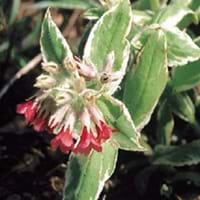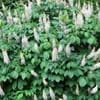Life Span
Perennial
Perennial
Origin
Southeastern United States
Europe
Types
Not available
Pulmonaria Bubble Gum , Pulmonaria ‘Polar Splash’ , Pulmonaria ‘Moonshine’
Number of Varieties
Not Available
Habitat
Bluffs, Coastal Regions, Stream side, Woods
Alpine Meadows
USDA Hardiness Zone
5-9
4-8
Sunset Zone
Not Available
1a, 1b, 2a, 2b, 3a, 3b, 4, 5, 6, 7, 8, 9, 14, 15, 16, 17
Habit
Spreading
Cushion/Mound-forming
Flower Color
White, Pink
Red, Salmon, Coral
Flower Color Modifier
Bicolor
Not Available
Fruit Color
Brown
Non Fruiting Plant
Leaf Color in Spring
Green
Dark Green
Leaf Color in Summer
Dark Green
Dark Green
Leaf Color in Fall
Lemon yellow, Yellow green
Dark Green
Leaf Color in Winter
Not Available
Light Green
Leaf Shape
Palmate
Lanceolate
Plant Season
Spring, Summer, Fall
Spring, Summer, Fall
Sunlight
Full Sun, Partial Sun, Partial shade
Partial Sun, Partial shade, Full Shade
Type of Soil
Clay, Loam, Sand
Clay, Loam
The pH of Soil
Acidic, Neutral, Alkaline
Acidic, Neutral, Alkaline
Soil Drainage
Average
Average
Bloom Time
Summer, Late Summer
Early Spring, Spring, Late Winter
Tolerances
Salt, Wind
Drought, Rocky Soil
Where to Plant?
Ground, Pot
Ground, Pot
How to Plant?
Cuttings, Seedlings
Divison
Plant Maintenance
Low
Medium
Watering Requirements
Keep the Soil well drained, Requires regular watering
Keep ground moist, Keep the Soil well drained
In Summer
Lots of watering
Lots of watering
In Spring
Moderate
Moderate
In Winter
Average Water
Average Water
Soil pH
Acidic, Neutral, Alkaline
Acidic, Neutral, Alkaline
Soil Type
Clay, Loam, Sand
Clay, Loam
Soil Drainage Capacity
Average
Average
Sun Exposure
Full Sun, Partial Sun, Partial shade
Partial Sun, Partial shade, Full Shade
Pruning
Remove damaged leaves, Remove dead branches, Remove dead flowers, Remove dead leaves
Prune after flowering, Remove damaged leaves, Remove dead branches, Remove dead leaves
Fertilizers
14-14-14 Fertilizer, Apply N-P-K, slow-release fertilizers
All-Purpose Liquid Fertilizer, Compost
Pests and Diseases
Edema, Powdery mildew, Verticillium Wilt
Pest Free, Powdery mildew
Plant Tolerance
Salt, Wind
Drought, Rocky Soil
Flower Petal Number
Single
Single
Foliage Texture
Coarse
Medium
Foliage Sheen
Matte
Matte
Attracts
Butterflies, Hummingbirds
Hummingbirds
Aesthetic Uses
Cottage Garden, Showy Purposes
Borders, Informal Hedge, Ornamental use, Showy Purposes, Woodland margins
Beauty Benefits
Not Available
Not Available
Environmental Uses
Air purification, Wildlife
Air purification
Medicinal Uses
Antirheumatic, Colic, constipation, Piles
No Medicinal Use
Part of Plant Used
Seeds
Not Available
Other Uses
Used for making soaps
Unknown
Used As Indoor Plant
No
Yes
Used As Outdoor Plant
Yes
Yes
Garden Design
Feature Plant, Foundation, Screening, Wind Break
Edging, Groundcover, Mixed Border, Rock Garden / Wall
Botanical Name
AESCULUS parviflora
PULMONARIA rubra 'David Ward'
Common Name
bottlebrush buckeye, dwarf horse chestnut
David Ward, Red Lungwort
In Hindi
Bottlebrush Buckeye
david ward
In German
Buckeye Putzer
david ward
In French
Bottlebrush Buckeye
david ward
In Spanish
bottlebrush Buckeye
david ward
In Greek
bottlebrush Buckeye
david ward
In Portuguese
Bottlebrush Buckeye
david ward
In Polish
Bottlebrush Buckeye
david ward
In Latin
bottlebrush Buckeye
david ward
Phylum
Magnoliophyta
Tracheophyta
Class
Magnoliopsida
Magnoliopsida
Order
Sapindales
Lamiales
Family
Hippocastanaceae
Boraginaceae
Genus
Aesculus
Pulmonaria
Clade
Angiosperms, Eudicots, Rosids
Not Available
Tribe
Not Available
Not Available
Subfamily
Hippocastanoideae
Not Available
Number of Species
Not Available
Season and Care of Bottlebrush Buckeye and David Ward
Season and care of Bottlebrush Buckeye and David Ward is important to know. While considering everything about Bottlebrush Buckeye and David Ward Care, growing season is an essential factor. Bottlebrush Buckeye season is Spring, Summer and Fall and David Ward season is Spring, Summer and Fall. The type of soil for Bottlebrush Buckeye is Clay, Loam, Sand and for David Ward is Clay, Loam while the PH of soil for Bottlebrush Buckeye is Acidic, Neutral, Alkaline and for David Ward is Acidic, Neutral, Alkaline.
Bottlebrush Buckeye and David Ward Physical Information
Bottlebrush Buckeye and David Ward physical information is very important for comparison. Bottlebrush Buckeye height is 180.00 cm and width 180.00 cm whereas David Ward height is 25.40 cm and width 81.30 cm. The color specification of Bottlebrush Buckeye and David Ward are as follows:
Bottlebrush Buckeye flower color: White and Pink
Bottlebrush Buckeye leaf color: Green
David Ward flower color: Red, Salmon and Coral
- David Ward leaf color: Dark Green
Care of Bottlebrush Buckeye and David Ward
Care of Bottlebrush Buckeye and David Ward include pruning, fertilizers, watering etc. Bottlebrush Buckeye pruning is done Remove damaged leaves, Remove dead branches, Remove dead flowers and Remove dead leaves and David Ward pruning is done Prune after flowering, Remove damaged leaves, Remove dead branches and Remove dead leaves. In summer Bottlebrush Buckeye needs Lots of watering and in winter, it needs Average Water. Whereas, in summer David Ward needs Lots of watering and in winter, it needs Average Water.





